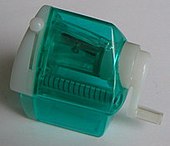
A knife is a tool or weapon with a cutting edge or blade, usually attached to a handle or hilt. One of the earliest tools used by humanity, knives appeared at least 2.5 million years ago, as evidenced by the Oldowan tools. Originally made of wood, bone, and stone, over the centuries, in step with improvements in both metallurgy and manufacturing, knife blades have been made from copper, bronze, iron, steel, ceramic, and titanium. Most modern knives have either fixed or folding blades; blade patterns and styles vary by maker and country of origin.

A pencil is a writing or drawing implement with a solid pigment core in a protective casing that reduces the risk of core breakage, and keeps it from marking the user's hand.

A cam is a rotating or sliding piece in a mechanical linkage used especially in transforming rotary motion into linear motion. It is often a part of a rotating wheel or shaft that strikes a lever at one or more points on its circular path. The cam can be a simple tooth, as is used to deliver pulses of power to a steam hammer, for example, or an eccentric disc or other shape that produces a smooth reciprocating motion in the follower, which is a lever making contact with the cam. A cam timer is similar, and were widely used for electric machine control before the advent of inexpensive electronics, microcontrollers, integrated circuits, programmable logic controllers and digital control.
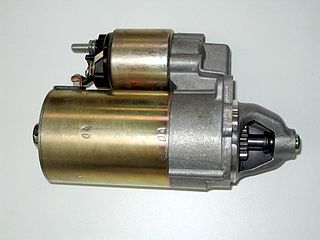
A starter is a device used to rotate (crank) an internal-combustion engine so as to initiate the engine's operation under its own power. Starters can be electric, pneumatic, or hydraulic. The starter can also be another internal-combustion engine in the case, for instance, of very large engines, or diesel engines in agricultural or excavation applications.

Shaving is the removal of hair, by using a razor or any other kind of bladed implement, to slice it down—to the level of the skin or otherwise. Shaving is most commonly practiced by men to remove their facial hair and by women to remove their leg and underarm hair. A man is called clean-shaven if he has had his beard entirely removed.

A crank is an arm attached at a right angle to a rotating shaft by which circular motion is imparted to or received from the shaft. When combined with a connecting rod, it can be used to convert circular motion into reciprocating motion, or vice versa. The arm may be a bent portion of the shaft, or a separate arm or disk attached to it. Attached to the end of the crank by a pivot is a rod, usually called a connecting rod (conrod).

A peeler is a kitchen tool, a distinct type of kitchen knife, consisting of a metal blade with a slot with a sharp edge attached to a handle, used to remove the outer layer of some vegetables such as potatoes, broccoli stalks, and carrots, and fruits such as apples and pears. A paring knife may also be used to peel vegetables. The blade of a peeler has a slot with one side sharpened; the other side of the slot prevents the blade from cutting too far into the vegetable.

A razor is a bladed tool primarily used in the removal of body hair through the act of shaving. Kinds of razors include straight razors, safety razors, disposable razors, and electric razors.
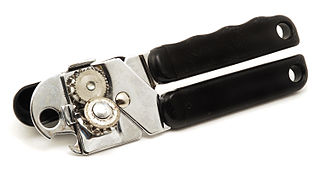
A can opener or tin opener is a mechanical device used to open metal tin cans. Although preservation of food using tin cans had been practiced since at least 1772 in the Netherlands, the first can openers were not patented until 1855 in England and 1858 in the United States. These early openers were basically variations of a knife, though the 1855 design continues to be produced.

A jackhammer is a pneumatic or electro-mechanical tool that combines a hammer directly with a chisel. It was invented by William McReavy, who then sold the patent to Charles Brady King. Hand-held jackhammers are generally powered by compressed air, but some are also powered by electric motors. Larger jackhammers, such as rig-mounted hammers used on construction machinery, are usually hydraulically powered. These tools are typically used to break up rock, pavement, and concrete.

Woodturning is the craft of using a wood lathe with hand-held tools to cut a shape that is symmetrical around the axis of rotation. Like the potter's wheel, the wood lathe is a mechanism that can generate a variety of forms. The operator is known as a turner, and the skills needed to use the tools were traditionally known as turnery. In pre-industrial England, these skills were sufficiently difficult to be known as "the mysteries of the turners' guild." The skills to use the tools by hand, without a fixed point of contact with the wood, distinguish woodturning and the wood lathe from the machinist's lathe, or metal-working lathe.
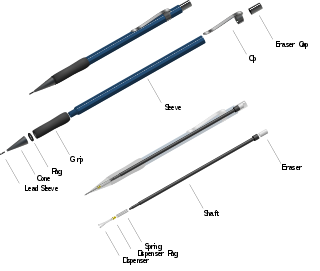
A mechanical pencil, also clutch pencil, is a pencil with a replaceable and mechanically extendable solid pigment core called a "lead". The lead, often made of graphite, is not bonded to the outer casing, and can be mechanically extended as its point is worn away as it is being used. The vast majority of mechanical pencils have erasers.

An electric shaver is a razor with an electrically powered rotating or oscillating blade. The electric shaver usually does not require the use of shaving cream, soap, or water. The razor may be powered by a small DC motor, which is either powered by batteries or mains electricity. Many modern ones are powered using rechargeable batteries. Alternatively, an electro-mechanical oscillator driven by an AC-energized solenoid may be used. Some very early mechanical shavers had no electric motor and had to be powered by hand, for example by pulling a cord to drive a flywheel.

A straight razor is a razor with a blade that can fold into its handle. They are also called open razors and cut-throat razors. The predecessors of the modern straight razors include bronze razors, with cutting edges and fixed handles, produced by craftsmen from Ancient Egypt during the New Kingdom. Solid gold and copper razors were also found in Ancient Egyptian tombs dating back to the 4th millennium BC.

A mixer is a kitchen device that uses a gear-driven mechanism to rotate a set of "beaters" in a bowl containing the food or liquids to be prepared by mixing them.
A writing implement or writing instrument is an object used to produce writing. Writing consists of different figures, lines, and or forms. Most of these items can be also used for other functions such as painting, drawing and technical drawing, but writing instruments generally have the ordinary requirement to create a smooth, controllable line.

Sharpening is the process of creating or refining the edge joining two non-coplanar faces into a converging apex, thereby creating an edge of appropriate shape on a tool or implement designed for cutting. Sharpening is done by removing material on an implement with an abrasive substance harder than the material of the implement, followed sometimes by processes to polish/hone the sharp surface to increase smoothness.

Knife sharpening is the process of making a knife or similar tool sharp by grinding against a hard, rough surface, typically a stone, or a flexible surface with hard particles, such as sandpaper. Additionally, a leather razor strop, or strop, is often used to straighten and polish an edge.
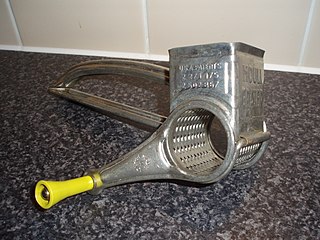
A Mouli grater or rotational grater is a hand-operated kitchen utensil designed for grating or pureeing small quantities of food. The device consists of a small metal drum with holes that grate the food and a handle for turning the drum.
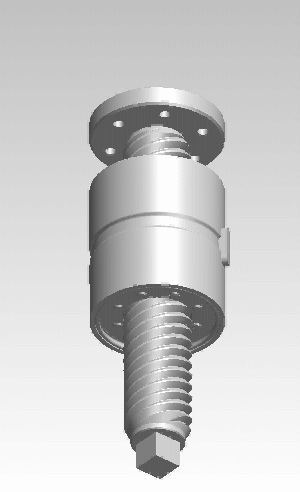
A roller screw, also known as a planetary roller screw or satellite roller screw, is a low-friction precision screw-type actuator, a mechanical device for converting rotational motion to linear motion, or vice versa. Planetary roller screws are used as the actuating mechanism in many electro-mechanical linear actuators. Due to its complexity the roller screw is a relatively expensive actuator, but may be suitable for high-precision, high-speed, heavy-load, long-life and heavy-use applications.


